There is something both calming and captivating when visiting European churches. They are more than places of worship but works of art and historical structures that transcend time. I find European churches fascinating, especially cathedrals, and make it a point to go inside when passing by them. Denmark’s Roskilde Cathedral or Domkirke was unlike any church we’ve ever visited.
Our main purpose was for a day trip to Roskilde, Denmark’s former medieval capital, was to explore the Viking Ship Museum. We had a good dose of Vikings and ships.
But, the town’s other main attraction was the cathedral which was a UNESCO World Heritage site. We saw its tall spires from different parts of town. Other than being the town’s parish, this was also the main burial place of the Danish royalty since the 15th century.
History of Roskilde Cathedral
They honored these monarchs in various chapels throughout the church. We’ve visited some mausoleums but this had to be the most lavish.
It felt like visiting a museum with its collection of frescoes, paintings and sculptures. This was the first time I’d heard of funerary art and it was at its finest.
Many churches once stood at this location for more than 1,000 years. The Roskilde Cathedral was first built in 1170 and construction took more than 100 years using 3 million fired clay bricks.
The French-inspired Gothic red brick structure had many chapels added throughout the years. Each chapel was distinct based on the monarch’s wishes and personality. Each section shows off different architectural styles based on when they built it.
Roskilde Cathedral Chapels
The first chapel we saw was the Chapel of the Magic which Christian I built containing extravagant, canopied sepulchre or burial vaults for himself and his queen. They buried two of his children in small chambers under the floor.
The well-preserved frescoes were impressive here including ones on the ceiling.
Built in the Dutch Renaissance Style, the medieval decorations covered most of the walls, depicting a variety of saints and angels meant to show the “daily intercession” for the royal family’s souls.
Frederik V Chapel
Prominent architects designed these chapels. Down the walkway, we saw Frederik V’s chapel, built in a Neoclassical style and completed in 1789.
Considered as an absolute monarch, he wanted to be glorified and buried with the same honors as Roman emperors. The white monument had two female statues grieving for the king and symbolize Denmark and Norway.
There were twelve other royal tombs in this chapel including five sarcophagi and fabric-covered coffins. It was fascinating to see how they entombed the monarchs, each with its own unique style—some more grandiose and pretentious than others.
It was a shame some of them didn’t get to see it. Those who planned well in advance made sure their resting places would be admired by many.
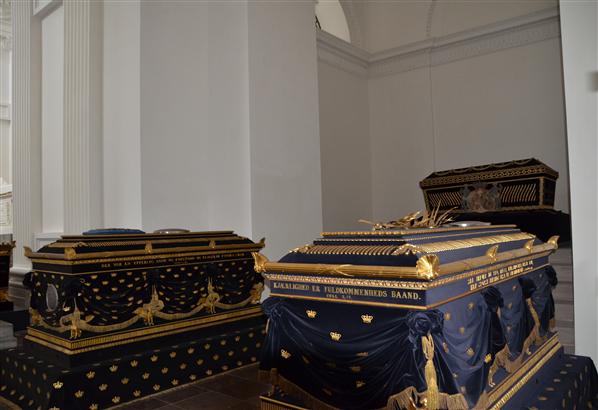
We felt a sense of eeriness and morbidity as we walked around numerous tombs, floor plaques and knowing there were many more graves underneath the cathedral floor. It felt really strange taking pictures of tombs and coffins but we couldn’t stop.
Most of them were decorated so beautifully. It was as if each monarch was trying to outdo their predecessors in terms of tomb and chapel opulence. This was fairly evident with Christian IV’s chapel.
Built in 1620, two large paintings illustrated important scenes from Christian IV’s life – a sea battle and as a judge and his statue watching over the chapel. We also saw five ornately decorated coffins here, with his being the silver and black one.
This decorative ceiling and walls were not a surprise after visiting Christian IV’s royal residence, Frederiksborg Castle, a few days earlier.
This was one of the stunning iron work separating the chapel from the church.
Glucksburger Chapel
The Glucksburger Chapel, built in 1924 and inspired by Romanesque and Byzantine styles, provided a stark contrast in simplicity and more recent design. King Christian IX, who reigned for 43 years, and Queen Louise were entombed in a double sarcophagus topped with golden crowns.
The three female sculptures surrounding it were Remembrance, Love and Grief.
St. Birgitta Chapel
St. Birgitta’s Chapel will be the future “sepulchral monument” of the current royal couple, Queen Margrethe II and the Prince Consort. She’ll be buried in a glass sarcophagus as depicted in this small model. Definitely unique and modern for the 21st century queen.
St. Andrew’s Chapel
They used the smaller St. Andrew’s Chapel for some religious services. The highlight here was the altarpiece made of 56,000 small glass mosaic tiles representing Christ’s tears falling.
Various frescoes dating back to 1511 show some religious scenes including the apostle Andrew for which this chapel was named. Even the simple chapels manage to have some stunning relics in them.
It was hard to ignore the other features of the church beyond the tombs. The centerpiece was the gold three-piece altar which was made in Antwerp in the mid-1500s.
It showed the various scenes from Christ’s life. The details were stunning and sparkled with the sun’s rays shining in through the windows.
We walked behind the altar and saw more monarch and noblemen’s elaborate marble tombs with carved portraits on top. There were nearly 40 kings and queens buried in the cathedral but they were spread out so it never felt like a crypt obstacle course.
The most prominent sarcophagus behind the altar was of Queen Margrete I, Denmark’s first queen, whose remains have been in Roskilde since 1413. The sculpture of the queen lying in state with golden crowns was striking. Its sides decorated with intricate carvings of small religious figures embellished with gold accents.
King Christian IV donated the impressive pulpit to the side in 1610. It was made of brick and sandstone with a wooden entrance. I loved the details in the side panels here.
The eye-catching private box hanging high above the cathedral walls were incredible. King Christian IV had this two-room box installed with two floors of ornate, multi-colored and gold decorations. I doubt they used this box much anymore during church services.
Final Thoughts on Roskilde Cathedral
It’s always a challenge bringing children to churches and this mausoleum had me a bit worried of creeping them out. Surprisingly, my kids were fascinated with all the sculptures and frescoes. They asked amusing questions like “Are there really dead people in those?” and “Are there ghosts around here, then?”
We gave them a camera and a smartphone and the worries went away. Tired, little feet found these wooden choir stalls dating back to 1420.
I never expected a day trip to see Vikings would also include this wonderfully unique Danish cultural heritage site. It was interesting to see the varying qualities on each monumental tomb – all masterfully crafted.
Roskilde Cathedral’s exterior may not be as impressive as other European churches but its interior deserves a leisurely stroll to fully appreciate its historic and religious art and architectural details.
Tips for Visiting Roskilde Cathedral Domkirke Denmark
- Visitors cannot enter the cathedral for touring during church services and ceremonies.
- There are no restrooms in the cathedral but public restrooms were at the nearby square.
- Free admission with the Copenhagen card. Admission is 70 DKK (about $10 US) for Adults; Kids under 18 are free.
- Guided tours are available for a fee.
- There is a Cathedral museum above Christian I’s chapel showing exhibits on the Cathedral’s history. Visitors can only go on specific times and accompanied by the staff.
- Roskilde was less than half an hour by train from central Copenhagen.
- Visit the cathedral website for more information.
*Have you visited other mausoleums or churches in your travels? How do you feel about visiting mausoleums as tourist attractions?
PIN IT NOW, READ LATER!

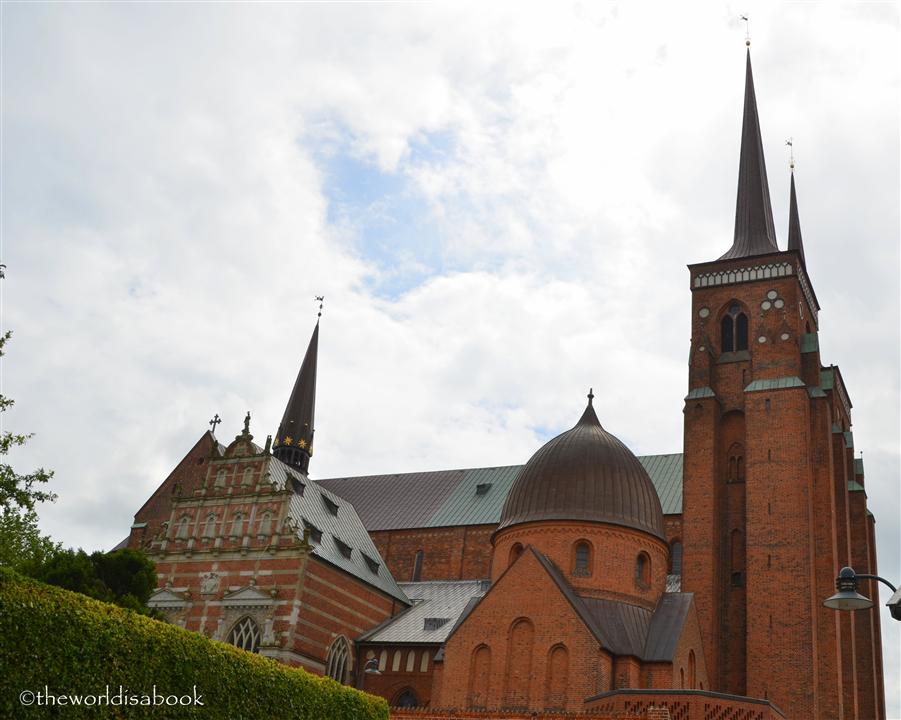
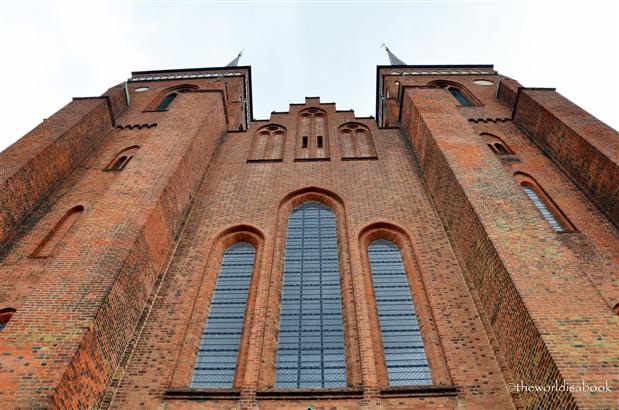
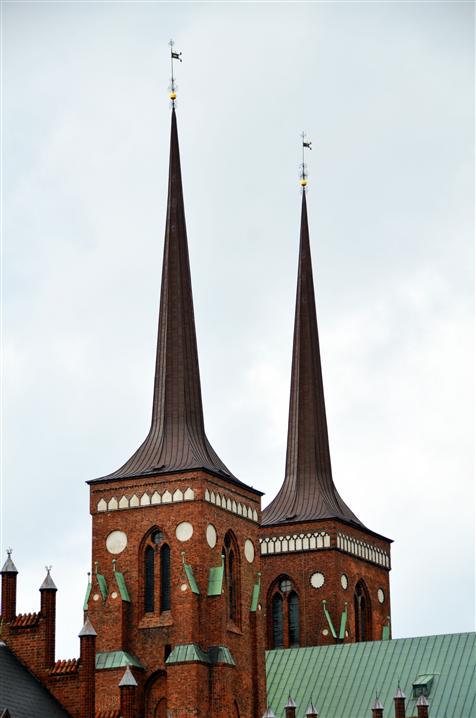
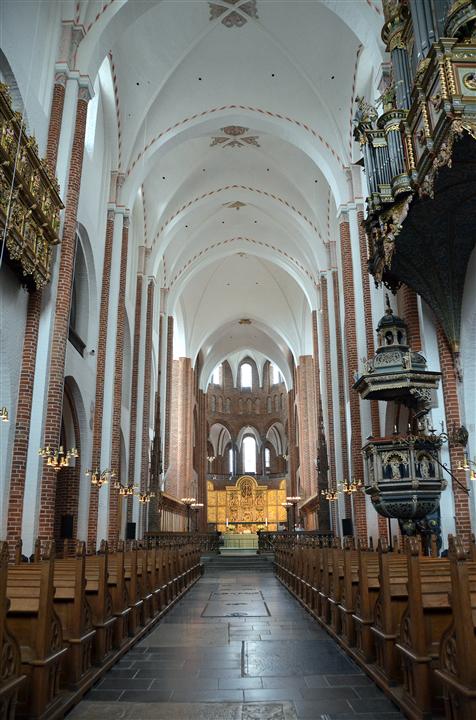
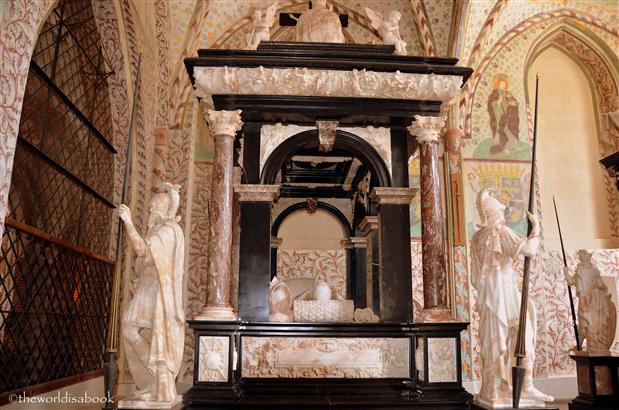
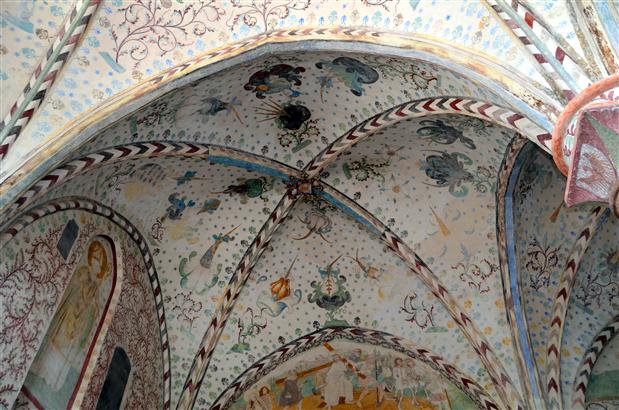
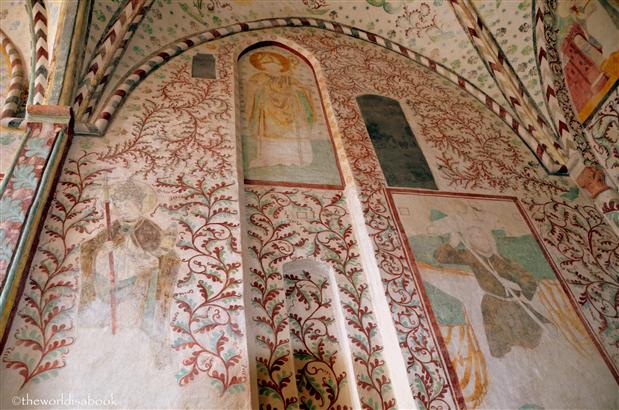
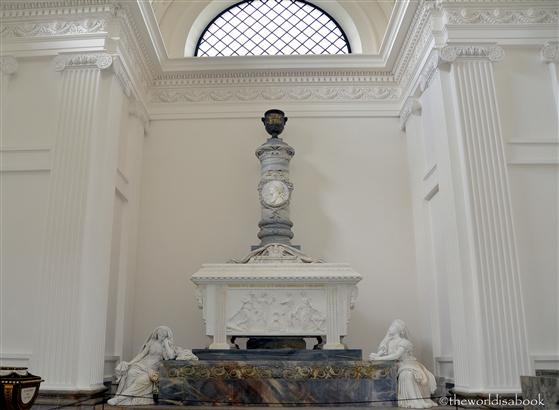
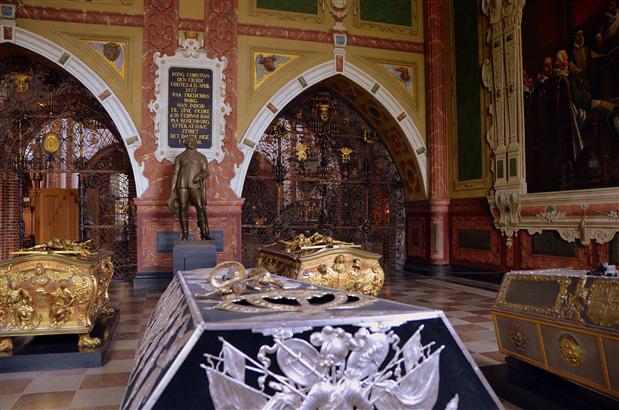
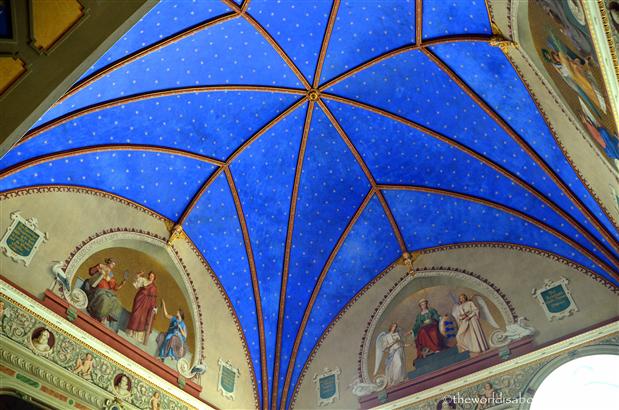
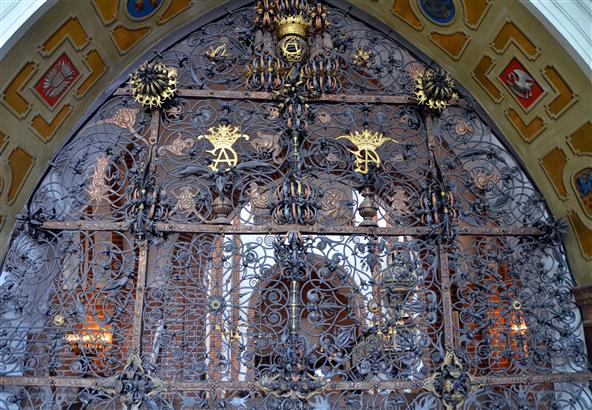
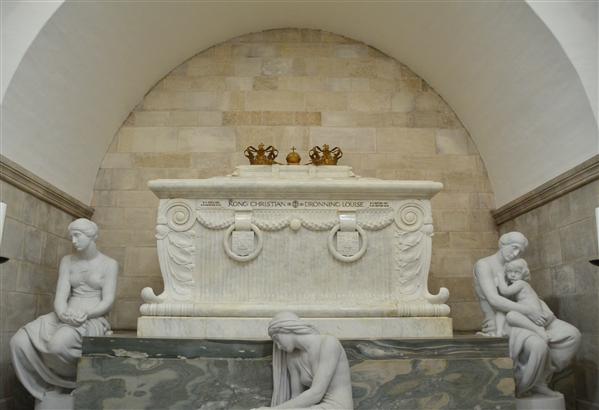
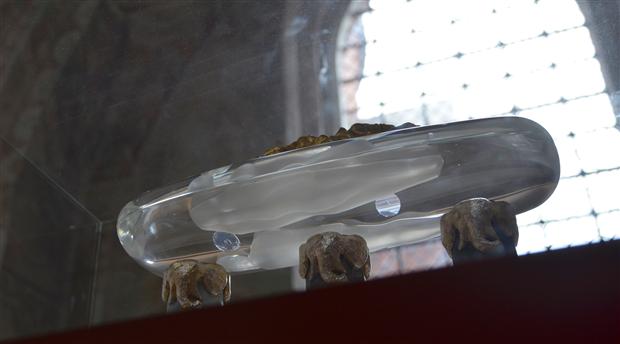
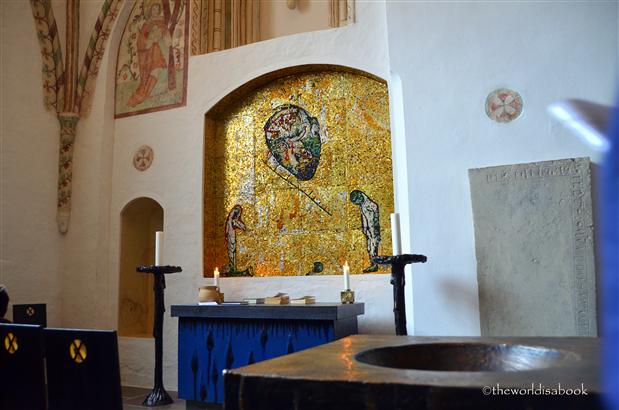
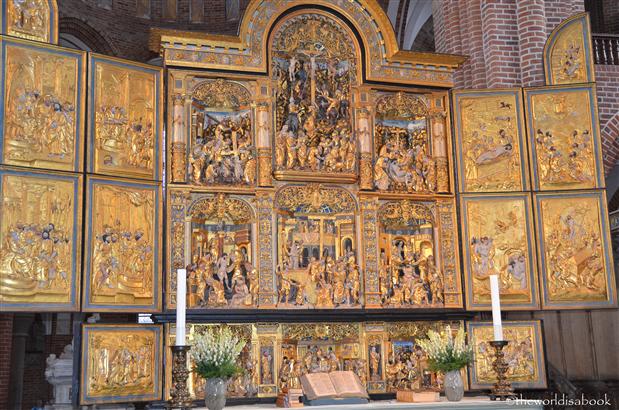
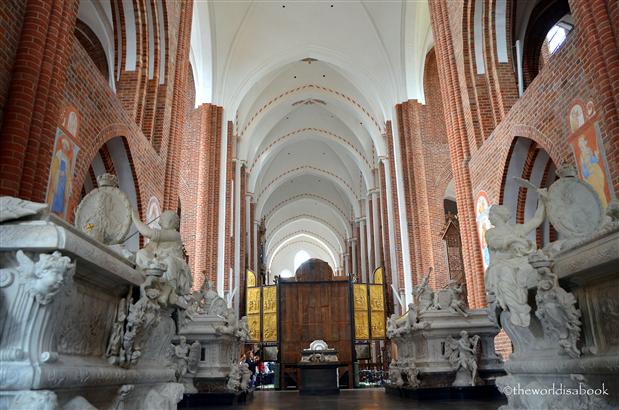
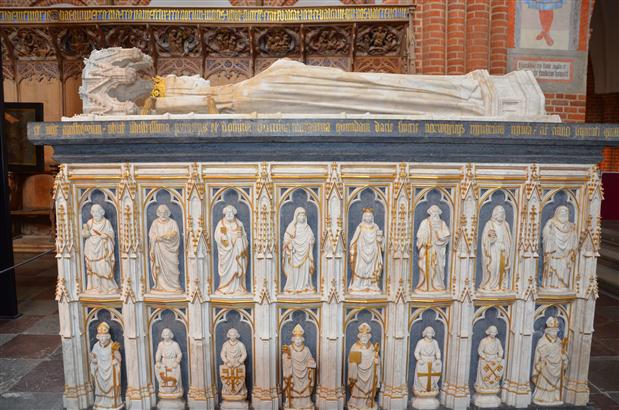
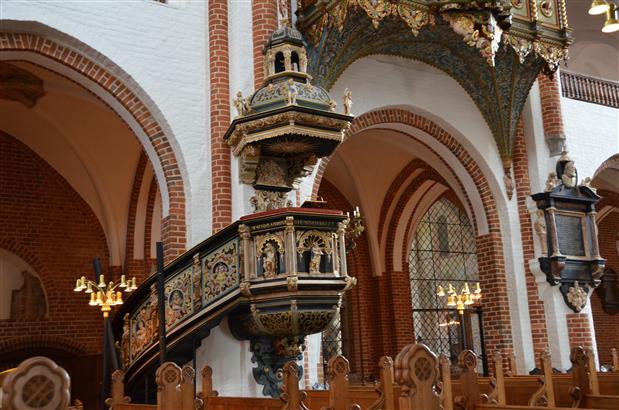
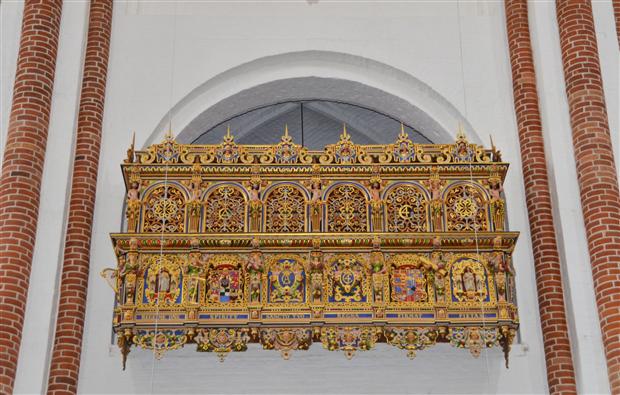
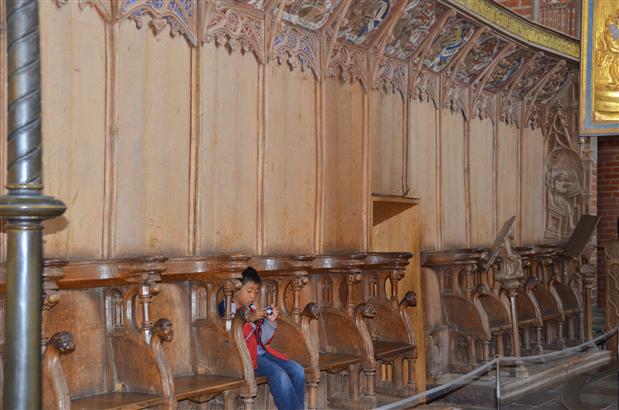
You really captured this church in its entirety. Lovely shots and an
interesting post.
I often visit church’s when I travel. I’ll be writing about a few
this month.
I visited Ho Chi Min’s mausoleum in HCM city. There is a waxed effigy of
him on display and you file past. You are not permitted to speak, and
the guards will tell you to be quiet if they see you talking. It
was one of the creepiest places I have ever been to.
Thanks Nancie! Looking forward to reading more about Prague and Budapest churches. Ho Chi Min’s mausoleum would be an interesting visit but that’s just too many restrictions and I’m assuming pictures are not permitted.
A collection of lovely photos. My favs were the ph so pointy spires, and the
blue dome ceiling.
Thank you Jan! The blue dome ceiling was very comforting and was abit more simple than the rest of the chapels but still beautiful.
Wow what an interesting post! I loved the photos and your narrative kept me captured to the very end. Great information!
Thank you so much Jackie! I’m glad you enjoyed the post.
What a fabulous post Mary.The beautiful frescoes in the chapels and workmanship in the sarcophogi were amazing. It must have been so interesting to follow the changes in decoration through the centuries.
Thanks Jenny! It was like a history lesson in art and architecture walking through the chapels. From an average traveler’s perspective with no art background, it managed to hold my interest.
Up here in Scandinavia, the name Roskilde is most of all associated with a huge rock festival every summer :)
I like Roskilde Domkirke and especially the beautiful burial chambers. Interestingly, Harald Bluetooth built and was buried in a small stave church that once stood where the cathedral now is. So perhaps a Viking ghost or two roams about, too :)
I’ve heard of the Roskilde fest only because I was researching and saw the Pearl Jam incident. So sad. I’ll be sure to share the Harald Bluetooth information to the kids. Viking ghost stories should perk up their interest. Thanks Sophie!
Thanks again for giving me a fresh view of a very well known place. I guess it’s a kind of snow blindness that applies sightseeing as well.
I love reading other bloggers’ post and point of view of my hometown sights. I hope I’m doing some justice with your hometown’s attractions. Love Denmark!
I love how you shot the church from all different angles – beautiful! I’m a sucker
for UNESCO World Heritage Sites.
Thanks Laurel! It doesn’t look as beautiful as other world heritage sites from the outside but its contents definitely make it a top notch on the list.
Great photos :)
Thanks Muza-chan!
Beautiful shots of this overwhelming cathedral. It is such a contrast to what I usually think of with Denmark–spare modern design.
Appreciate the kind words Vera! I know what you mean about the very modern look of Denmark and much of Scandinavia. We actually found a lot of beautiful churches and castles that make Denmark so fairy tale looking.
What a stunning church – it must have been like walking through Danish history seeing the tombs of so many monarchs. I had no idea that this church existed. We had planned to take the train to Roskilde to the Viking Museum on the day that our cruise ended but we were just too exhausted. I really hope to get back to see more of Denmark some day and Roskilde is a place that I want to see – now I know that this church is there too. Beautiful photos, Mary!!
Thank you, Lisa! It was a great experience to see so many fancy tombs. A bit creepy at times but definitely worth the visit. Sorry you didn’t make it to the Viking Museum. I think the girls would have loved it including a “dress like a Viking” area. Hope you make it back to Denmark soon.
Your photos really captured the beauty of this church! You really took some amazing pictures! I do visit a lot of churches, cemeteries and mausoleums when traveling. I love them but agree it does seem a bit disrespectful. I try to be as respectful as possible while snapping away!
Thank you for the kind words as always, Debbie! We’ve tried to stay away from cemeteries because of the kids and not scaring the kids too much. I feel disrespectful in addition to feeling strange too – like I’m invading someone’s private space. But they made it too beautiful not to snap away.
Like you, I love visiting European churches and cathedrals, but I haven’t had the opportunity to visit Denmark yet. Beautiful churches you’ve written about here. I love the decorations at teh Chapel of the Magic.
Thanks Cathy! I hope you make it to Denmark soon. They certainly have their fair share of beautiful churches and castles.
You truly captured this amazing church in all its splendor — and I know how difficult it was because while there, we had a heck of a time getting a good shot. The streets are laid out in such a way as to not get a vantage point.
Nevertheless, you have presented the outside, inside, and history beautifully. Thanks for the lovely post.
~Josie
Thanks Josie! I’m glad you enjoyed the post. I hope you had a great visit to Roskilde cathedral too. I know what you mean about getting a good angle. There were so many buildings around it and that square in front of it was too small to fully capture it.
What an interesting and beautiful place. I love to visit churches during my travels (especially in Mexico), but I have to admit that mausoleums/cemetaries totally creep me out :-) Love the detail and the thought that you put into your pictures and posts!
Thank you Andi! You are too kind. I know what you mean about visiting mausoleums and cemetaries. They’re not exactly in the family friendly places to visit. I had to ask my kids if they were okay seeing many many tombs and I’m glad they got to experience this. we’ve only been to a church or two in Mexico and I would love to see more. I can imagine all the beautiful artwork and tilework.
The colors are unbelievable! Most churches from that long ago have list most color – except in the stained glass windows. So, this really is very different. The frescoes are impressive and the ceilings are really neat too.
Their frescoes and ceiling were really well-preserved especially for the cathedral being a parish too. It was very different but worth the visit for beautiful art. Thanks for stopping by, Sabrina!
I enjoy visiting places like this, mostly because I studied art history (and lots of cathedrals) in college, but I have never heard of this one. What an interesting place and way to learn about Danish history. I especially liked the frescoed ceilings you captured.
I know you’d love this place with your art background. It would be interesting to read a post from you after visiting this cathedral from your expert perspective. It was wonderful to learn about history and architecture through monumental tombs.
Stunning – your pictures are gorgeous, so I can only imagine how beautiful it is to see this in person. I’m with you – I love the history of European churches – especially the ones that are not as well known.
Thanks Becca! Yes, these pictures don’t do the frescoes any justice. This was a pleasant surprise to visit and European churches are just a joy to visit because they have so much history and much fancier than the ones we have here in the US.
Great pictures Mary. Personally, I’m of the opinion that if you want to glam up your final resting place as much as these people do then attention, including pictures, should be expected. Glad you took the time to take some great shots.
Thanks Steve! I loved your description of them – glamming them up. Don’t we all wish we get to have our final resting place as fancy as these? It was a bit creey but worth visiting and certainly an interesting visit.
What a thorough rundown on the church with some outstanding photos to go with it. I can’t get over the sights your kids have seen at such a tender age – and they always look so well behaved in the photos. I think your comment about churches being works of art is right on the mark. I can defintely appreciate them for that reason alone.
Thanks Leigh! We make sure they’re well-behaved in photos =) They’re great travelers and we make sure they behave even more in sacred places.
Some people (like my husband and kids) get tired of visiting churches and cathedrals, but I never do. I like to at least peak in every one I pass. Thanks for the info on this beauty in Denmark.
My husband gets tired of all the churches too but he sees it as an excuse to sightsee sitting down and to rest his feet. Love European churches. I would love to see those Seville ones you posted last week.
What a magnificent space! And those ornate coffins are quite a sight! We love to visit old churches and cathedrals. They’ve always fascinated me. I’d love to visit the European ones some day.
Thanks Tonya. I couldn’t believe how fancy those coffins were either. I hope you get to visit the European churches soon.
Lovely pictures, they give a good idea of this cathedral’s austere beauty.
Thanks Angela! I’m glad I was able to capture some of the church’s beauty to share with all of you. It really does need to be visited in person to see its full glory.
Thanks Christine! The frescoes were amazing. I can’t believe how well-preserved they were considering the age of this church.
I haven’t seen a Cathedral as beautiful as this! The structure is amazing! So breath-taking! Thanks for sharing those photos.
I visited this place too. Great pictures!!! It was even more beautiful than I remember.
I also love the magnificent cathedrals of Europe. Even some of the very small churches (like some I saw In Italy) had amazing interiors. Love your photos of the ornate decor (especially love the gold altar — and those coffins! Would enjoy visiting some of the Scandinavian churches sometime.